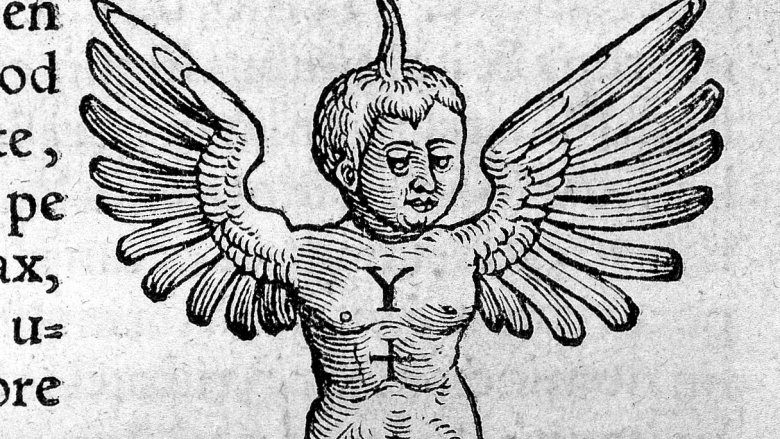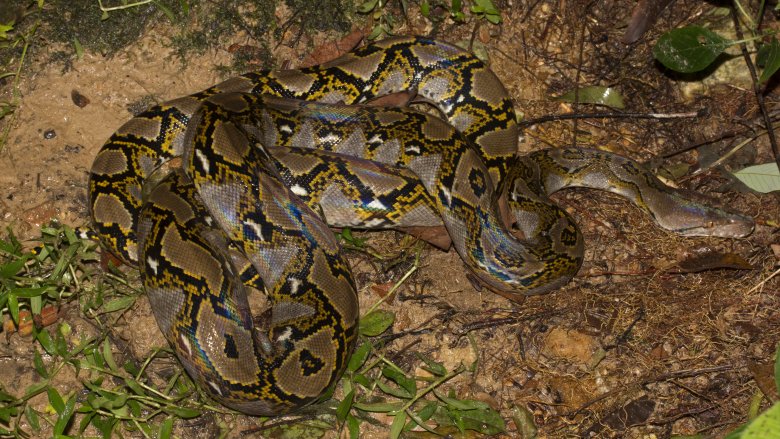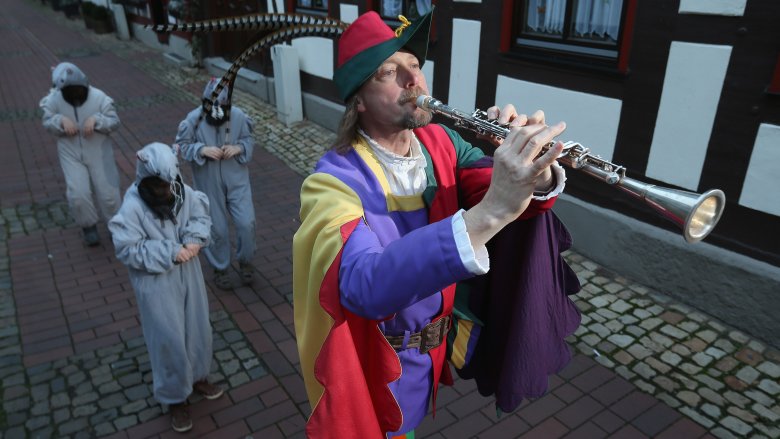Myths And Legends Based On Disturbing Truths
Mankind doesn't really have a lot going for it as a species, but one thing that's incredible is our ability to tell stories. For as long as there's been campfires to tell tales around, we've been coming up with the most amazing and outlandish myths and legends to explain the world around us. And sometimes, the truth we're trying to explain is more horrifying and more heartbreaking than the stories we dream up.
Vampire legends were inspired by TB outbreaks
Before vampires turned into the glittering figures of today's pop culture landscape, they were the stuff of nightmares, not teen fantasies. And the world has had some very real vampire panics. In the 19th century, those panics started when entire families fell victim to a mysterious wasting sickness. The sick were described as having a pale, sweaty complexion and a bloody cough, acting as though the life was slowly being drained from them. Today, we know it was tuberculosis, but at the time, people believed supernatural creatures were feeding on their loved ones.
Townsfolk claiming their deceased loved ones were returning from the grave to feed on the living started digging up and desecrating remains to stop these so-called vampires. Historians (via Smithsonian) have collected newspaper reports confirming these tragic disinterments happened in Woodstock, Vermont, in 1830; in Jewett City, Connecticut, in 1854; and in Rhode Island in 1892 — all during instances of TB outbreaks.
The most famous case was that of the Brown family of Exeter, Rhode Island. The Browns buried their mother first, then a sister. Almost 10 years passed before Mercy "Lena" Brown showed symptoms of TB (this strain was a lingering variety), and while she was dying, her brother suddenly grew sicker. After she died, neighbors convinced the Brown patriarch to dig up his relatives in case one was returning to feed on the village's living residents. While the sister and mother were long-decayed, Lena's body was still preserved; her heart and liver were removed, burned, and fed to her brother to save him. It didn't work.
The terrifying tale of India's Skeleton Lake
There's a song in Himalayan traditions that tells the story of a group of outsiders who climbed a mountain — and in doing so, defiled a divine sanctuary. The goddess of the mountain was so angry that she hurled hailstones down on the travelers and killed them all. Just a story, right? Not so fast, because in 1942, British soldiers stumbled across more than 200 human skeletons high up in the Himalayas. It wasn't until around 60 years later that we took a closer look, and learned the bodies were the remains of those original pilgrims whose untimely deaths had inspired the tragic tale.
The summer of 1942 was particularly warm, and when the ice of India's Roopkund Lake melted more than usual, it revealed the skeletons that had been entombed in the ice. The British troops first assumed the remains had some connection to World War II, but when they determined they were too old, they moved on. There were more important things going on, after all, and according to Atlas Obscura, it wasn't until 2004 that scientists determined the remains dated back to around 850 A.D. They also determined that the group was killed from blows that rained down on them from above, and that the only likely explanation was that they had been caught in and killed by a freak hailstorm, which was then remembered for centuries after in a traditional story.
Charlie No Face
Parents who live in western Pennsylvania tell their children of a terrifying figure. Anyone out past curfew and up to no good is likely to run into the Green Man, a monstrously disfigured man who roamed the rural roads after dark. He lived in an abandoned railway tunnel, and he could disable cars with his touch — a leftover curse from the same terrible accident that had disfigured him.
It sounds like a standard urban legend, except for one heartbreaking detail that was tracked down by Roadtrippers. Despite having no car-stopping superpowers, the Green Man was real. His name was Raymond Robinson, but locals knew him as Charlie No Face.
Robinson was just a boy in 1918, and was climbing on a train bridge when he touched a power line. He was blinded, losing most of his face and an arm. People are, of course, jerks, and would become the target of all kinds of cruelty. He could walk at night without being harassed, though, so that's what he did. The truth grew into legend, and by the time he died in 1985, there were all kinds of stories that came with photographic proof. Those who had stopped to chat with him found he was a pretty nice guy who was happy to pose for a picture, often in trade for a beer or two, while chatting with those who took the time to get to know him.
The Odyssey and Circe
Let's start with a quick recap in case you don't remember reading The Odyssey in school. Odysseus and his men find themselves on the island of the sorceress Circe. She welcomes the sailors and fixes them a meal, including a potion that causes serious amnesia. She turns the men into pigs, save one that warns Odysseus about what's going on. Our hero conveniently runs into the god Hermes, who gives him an antidote: a black-rooted herb with a white flower.
While it's obviously unlikely that Circe actually turned the sailors into pigs, Discover Magazine says the story has a kernel of truth to it. There really is a plant that causes things like amnesia, delirium, and hallucinations: jimson weed. It's part of the nightshade family, and it was a well-known poison in the ancient world.
As for Hermes' herbal cure, that was likely real, too. In the 1950s, Russian scientists started looking into a folk remedy that turned out to have some real medicinal value. The flowers of a snowdrop — which fit Homer's detailed description — were used as both a general pain reliever and to help treat polio. Research found the plant contains compounds that can protect certain neurotransmitters in the brain, the same thing that jimson weed attacks. These days, it's being investigated as a possible treatment for Alzheimer's. It's too bad it took us hundreds of years to rediscover its benefits.
The Monster of Ravenna
History is filled with a ton of obscure monsters and terrifying tales that end up being little more than a footnote, and the Monster of Ravenna is one of those. According to The Guardian, we know about the so-called monster thanks to a Florentine apothecary who wrote of it in his diary. It was 1512, and he said that when the city was ravaged by invaders 18 days after a monster was born, everyone realized that its appearance was an ill omen.
Pope Julius II ordered the "monster" to be starved, but woodcuts and engravings depicting the monster's appearance spread across Italy and into Europe. Depictions vary, but it generally had wings, a single leg, and two sets of genitalia. Despite how improbable such a creature would be, there was likely a kernel of truth here, too.
The so-called monster was probably a very real child, and one born with severe birth defects. Modern science has even named the condition that the baby probably had: Roberts syndrome. The condition is characterized by abnormalities in the arms and legs, missing fingers and toes, multiple facial abnormalities, and abnormalities in their internal organs and genitalia. The syndrome is often fatal, but individuals with mild cases can survive. We know what causes it today — it's a genetic mutation — but in the past, such a child would have been a horrible omen... and treated as such.
The legend of Borneo's child-eating snakes
People in Borneo tell an ancestral tale of villagers who once headed deep into the jungle to escape colonization by the Dutch. This group settled down in a valley, but one by one, their children began to disappear. Eight children vanished over the course of eight nights, so the adults set a trap for whatever was raiding their village. They baited the trap with another child, and lured out something they called a dragon. Following it back to its lair, the villagers killed the two adult dragons they found there, then made a pact with the dragon child: the two species would never again harm each other.
When BBC correspondent Nadia Drake decided to figure out if this "dragon" was real, she found there weren't just a few snakes that were likely to have inspired the tale, there were a lot of snakes — roughly 150 different species. A look at the capabilities — and habits — of Borneo's native snake population led her to believe the legend of the dragon grew from encounters with all of these very real snakes.
When she asked her guide which of Borneo's snakes was the deadliest, the answer was, "It gets to a certain point where it doesn't really make a difference." Drake says the story was likely rooted in several snake species, and combined things like the hunting skills of the king cobra with the size — and child-swallowing capabilities — of the reticulated python. Those bad boys can grow to be 32 feet in length, and is literally "the longest snake in the world." Yeah, you'd probably think it was a dragon too.
The Pied Piper of Hamelin
You've heard the story of the Pied Piper of Hamelin. He's the one who appears in a German town and rids them of their rat problem. When they refuse to pay up, he plays another tune and leads all the village's children away as punishment. It's the stuff of fairy tales, sure, but The Portalist says there's some odd historical evidence that suggests it might have been based on a real event — we're just not sure what that event might have been, exactly.
The BBC says there are eyewitness accounts, written in the 1280s, that talk about a piper who led the town's children away. The actual story of the Pied Piper (as we know it) was first told around then, too, and the story is given an actual date: June 26, 1284. That's disturbingly specific, and the possibility that something very real did happen on that date is 100 percent supported by the Hamelin town chronicle, which contains an entry for June 26, 1384 that simply reads, "It is 100 years since our children left." There's also a memorial inscription in the town's gate, built in 1556. So what gives?
Clearly, something happened on that day, and one theory suggests the town's children were killed in a mass drowning or landslide, while other historians think a plague or other illness might have swept through and killed the town's most vulnerable. Yet another theory says the children were conscripted, either forced into military service, sold into slavery, or forced to emigrate and settle in new lands. Whatever happened, the townsfolk haven't forgotten their children. And thanks to the famous story, neither will the rest of the world.
Mermaids
Mermaids have gotten the same treatment as vampires. Even though they started out with some pretty dark stories attached to them, there are hundreds of people who legitimately say their day job is pretending to be a mermaid. Stories of mermaids are told across the globe, and there's a few different suspected sources for where the legend began. National Geographic says that one is the manatee, but seriously, no sailor would mistake one of those for a mermaid, no matter how long he's been at sea.
But there's got to be some reason that people would come up with the myth of the mermaid — and according to medical historian Lindsey Fitzharris, that's because of babies born with a condition called sirenomelia. The condition is usually fatal (although there have been children who have survived into their teen years), and it's caused when a fetus forms a singular artery for a singular leg instead of the standard two. Not only does that mean the baby develops one leg instead of two, but since the vascular system is so compromised, the lower limb doesn't get enough blood to correctly form, and ends up looking like a fish's tail.
The condition is extremely rare, but Fitzharris says babies with the condition rarely survived more than a few days. And, since they were occasionally exhibited in freak shows, they could have helped give credibility to the mermaid's existence.
The Maori legend of the man-eating bird
According to legend, the ancestors of the Maori people in New Zealand shared their lands with the Te Hokioi. It was a massive, man-eating bird, with black and white feathers, a red crest, and wings tipped with yellow and green. Accounts of the bird — and its penchant for human flesh — were told to some of the earliest European settlers of New Zealand, but it wasn't until fairly recently that scientists have confirmed the massive bird actually existed.
Today, we know it as Haast's eagle, and it's named after the explorer who found the a specimen's skeleton in the 1870s. It wasn't until recently that technology advanced to the point where we can analyze bones and translate that into understanding the skills it would have had when it was alive.
According to Paul Scofield, curator of vertebrate at the Canterbury Museum, "It was the equivalent of a lion." The eagle had a wingspan of almost 10 feet, weighed around 40 pounds, and could dive at speeds up to 50 mph. It hunted the moa, another massive bird — not unlike an ostrich, but much, much bigger. The moa, for its part, weighed in at around 550 pounds and stood around eight feet tall, so it was no slouch, either. Haast's eagle's downfall came when people hunted the moa to extinction about 1,000 years ago. Humans: moving in and killing things for centuries.
The Oracle at Delphi
From at least 1400 BC, pilgrims from all across Europe traveled to Delphi to ask the Pythia — a title given to Delphi's soothsaying priestess — their most important questions. Legend says that she was the voice of Apollo, and that her prophecies came from the god himself. It's impossible to tell how many decisions were based on her cryptic answers, but we do know that leaders from Greece and Rome went there to consult with her — and Apollo — until the whole thing was outlawed by a newly Christian Rome in 392.
According to National Geographic, it was Plutarch who first suggested the Pythia's visions came from vapors she was inhaling. The theory was mostly dismissed in the 1920s because of a French investigation, but in the late 1990s, geologists discovered that Delphi sits directly on the intersection between two fault lines. Earthquakes happen about every century or so, and it's just enough to shake loose gases that seep through the porous limestone. One of those gases is ethylene, which has a hallucinogenic effect.
The discovery seemed to confirm that while the Pythia wasn't exactly channeling Apollo, she was getting actual visions. Unfortunately for the women who filled the role of Pythia, they were confined to a small chamber and the accumulation of gases was occasionally deadly. Given what we know about Greek mythology, that actually sounds like precisely the sort of thing the gods would love.







